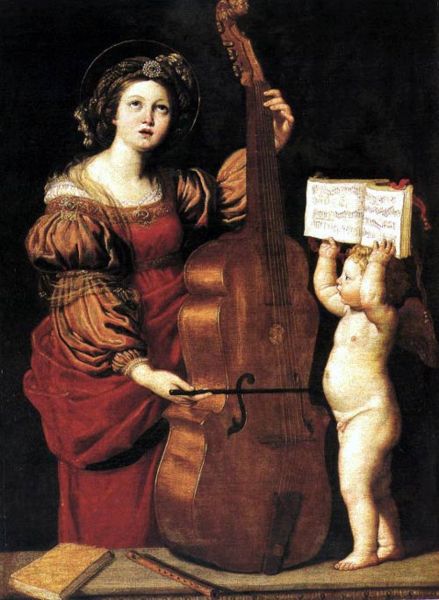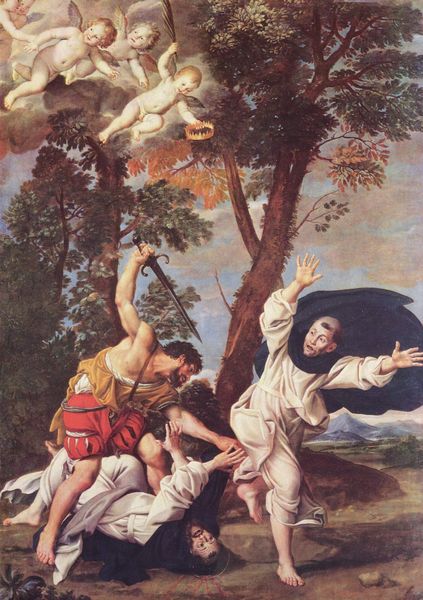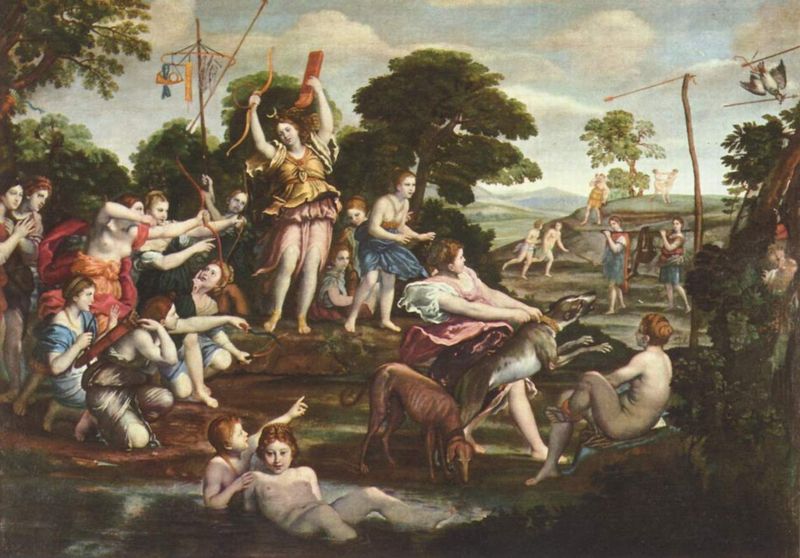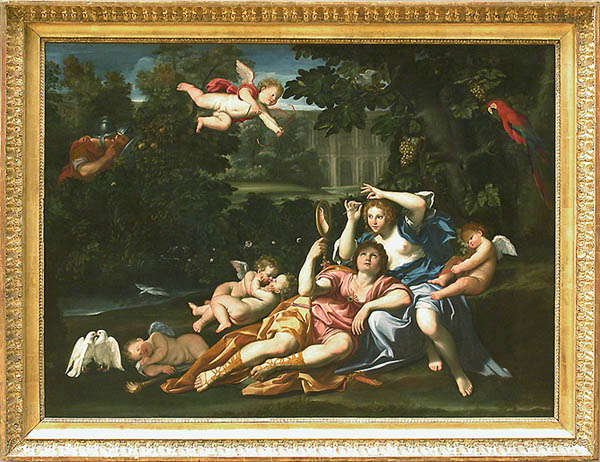Domenichino (1581-1641)
Get a Domenichino Certificate of Authenticity for your painting (COA) for your Domenichino drawing.
For all your Domenichino artworks you need a Certificate of Authenticity (COA) in order to sell, to insure or to donate for a tax deduction.
Getting a Domenichino Certificate of Authenticity (COA) is easy. Just send us photos and dimensions and tell us what you know about the origin or history of your Domenichino painting or drawing.
If you want to sell your Domenichino painting or drawing use our selling services. We offer Domenichino selling help, selling advice, private treaty sales and full brokerage.
We have been authenticating Domenichino and issuing certificates of authenticity since 2002. We are recognized Domenichino experts and Domenichino certified appraisers. We issue COAs and appraisals for all Domenichino artworks.
Our Domenichino paintings and drawings authentications are accepted and respected worldwide.
Each COA is backed by in-depth research and analysis authentication reports.
The Domenichino certificates of authenticity we issue are based on solid, reliable and fully referenced art investigations, authentication research, analytical work and forensic studies.
We are available to examine your Domenichino painting or drawing anywhere in the world.
You will generally receive your certificates of authenticity and authentication report within two weeks. Some complicated cases with difficult to research Domenichino paintings or drawings take longer.
Our clients include Domenichino collectors, investors, tax authorities, insurance adjusters, appraisers, valuers, auctioneers, Federal agencies and many law firms.
We perform Domenichino art authentication, appraisal, certificates of authenticity (COA), analysis, research, scientific tests, full art authentications. We will help you sell your Domenichino or we will sell it for you.

Domenico Zampieri (or Domenichino), was a prominent high Baroque Italian painter of the Bolognese School, or Carracci School, of painters. He was born at Bologna, son of a shoemaker, and there was initially apprenticed under Denis Calvart. Soon he left to work in the Accademia degli Incamminati of the Carracci brothers. Leaving Bologna for Rome (1601), he became one of the most talented apprentices to emerge from Annibale Carracci's supervision, working alongside a senior contemporary like Albani and Guido Reni, as well as lifetime rivals such as Lanfranco.

Because of his stature, he was nicknamed "little Domenico". The panel depicting The Maiden and the Unicorn (1604-5) in Annibale's Gallery series titled The Loves of the Gods is attributed to Domenichino. Also in the Palazzo Farnese he painted three mythologic landscapes in the Loggia del Giardino. With the support of Monsignor Giovanni Battista Agguchi, the maggiordomo to Cardinal Aldobrandini and later Gregory XV, and Giovanni's brother Cardinal Girolamo Agguchi, Domenichino obtained commission for the Cappella dei Santissimi Fondatori in the medieval basilica of the Abbey of Grottaferrata (1608-10) a few miles outside Rome, and where the titular abbot was Odoardo Farnese. He also was commissioned for frescoes in church of Sant'Onofrio. Albani saw that he participated in decorating the Palazzo Mattei (1606-07) and Villa Odescalchi at Bassano di Sutri (today Bassano Romano). Reni worked with him on frescoes in the Oratorio di Sant'Andrea and at San Gregorio Magno. Working on The Scourging of St. Andrew (a fresco in the church of San Gregorio Magno), the artist was rumored to work himself into a passion, using threatening words and actions, and that Annibale Carracci, surprising him, exclaimed with joy, "To-day, my dear Domenichino, thou art teaching me."

After the passing of Annibale in 1609, the Roman art scene was dominanted the master's pupils. Domenichino's next commissions were scenes al fresco of the life of St. Cecilia for the Polet Chapel of San Luigi dei Francesi (1613-1614). Domenichino painted in fresco in San Silvestro al Quirinale, San Carlo ai Catinari, Santa Maria in Trastevere, Sant'Andrea della Valle and Santa Maria della Vittoria in Rome, as well as in the Villa Aldobrandini at Frascati.
Both Annibale and Domenichino were among the few landscape artists of the early Roman baroque, and would influence Claude Lorrain in the next.

He was considered unsociable by many, and ultimately excited the rivalry of Lanfranco. Shortly after Domenichino had completed for the Oratorian church of San Girolamo della Carità his celebrated for Communion of St. Jerome (1614, Vatican Pinacoteca), Lanfranco circulated copies of Agostino Carracci's (1591-97) painting of the Ultima Comunione di San Girolamo, alleging, not wholly without merit, plagiarism. Inspection of the two mirrored canvases would suggest that while he closely paraphrases Agostino, the accusation of plagiarism is debatable, since Domenichino's treatment is sharper, less crowded, and more focused on the beggarly figure of St Jerome.

In 1630, Domenichino moved to Naples, to work on a series of frescoes (never wholly completed) of the life of St. Januarius in the Cappella del Tesoro. The so-called Cabal of Naples formed by the painters Corenzio, Ribera and Caracciolo banded together as to exclude non-Napolitan competition, and criticized and defaced the Bolognese artist's work. For instance, it is said he often found his previous day's work was rubbed out. Whether constant anxiety or rumored poison assailed him, he died in Naples in 1641.

Despite his prodigious output, Domenichino had a slow and labored style of painting, garnering him the nickname of Bue ("Ox") among Carracci acolytes. Domenichino, in the tradition of Annibale Carracci, restrained the late-Mannerist and Baroque impulses that were contorting the canvases of contemporaries; and aimed for a more settled peaceful representations.

Among the painters that apprenticed under him or which he influenced were Andrea Camassei (1602-1649), Giovanni Agnolo Canini, Giacomo Castro, Francesco Cozza (1605-82), Giovanni Domenico Cerrini, Francesco Grimaldi, Vincenzo Manenti, Francesco di Maria, Pietro del Po, Antonio Ricci (Barbalunga), Giovanni Battista Ruggieri, Giovanni Battista Salvi, il Sassoferrato (1609-85), Pietro Testa (1611-50), and Giovanni Domenico Cerrini (1609-81) Attributed work
- The Virgin, Infant Jesus, and John the Baptist, (1599-1600, Louvre Museum)
- The Assumption of the Blessed Virgin (1601) in the Rosary chapel of the Basilica of San Domenico in Bologna.
- Maiden with the Unicorn, (1602-4, Farnese Gallery, Palazzo Farnese, Rome; fresco under direction by Annibale Carraci) *Abraham Leading Isaac to Sacrifice, (1602, Kimbell Art Museum, Dallas)
- Landscape with Baptism of Christ, (Pinacoteca Nazionale di Bologna)
- Martyrdom of Saint Cecilia, (Pinacoteca Nazionale di Bologna)
- Portrait of Cardinal Aguchi, (1605, Uffizi, Florence)
- Landscape with Flight into Egypt, (1605, Oberlin College)
- Landscape with Hermit, (1606, Louvre)
- Landscape with Fording, (1607, Galleria Doria-Pamphilj)
- Scourging of Saint Andrew, (1608, San Gregorio Magno, Rome, commissioned by Scipione Borghese)
- The Rapture of St. Paul, (1608, Louvre)
- Myth of Diana, (1609, Palazzo Giustiniani, now Odescalchi, Bassano (di Sutri) Roman)
- Exequeys for a Dead Emperor, (1612, Prado Museum, Madrid)
- Landscape with Fortifications, (1634-5, Denis Mahon Collection, London)
- Cumaen Sybil, (1610, Pinacoteca Capitolina, Rome)
- Legends of SS. Nilus and Bartholomew, (1610, Abbey of Grottaferrata commissioned by Odoarde Farnese)
- Triumphal Arch of Allegories, (1610, Prado Museum)
- Way to Calvary, (1610, Getty Museum, California)
- Communion of St Jerome, (1614, Vatican Pinacoteca)
- Scenes of the life of St. Cecilia (1613-1614) Frescoes, San Luigi dei Francesi, Rome
- Saint Cecilia Giving Alms to the Poor
- Saint Cecilia before the Judge
- Landscape with St Jerome, (Glasgow Art Gallery and Museum)
- Landscape with Sylvia and Satyrs, (1614, Pinacoteca Nazionale di Bologna
- Timocles captive before Alexander the Great, (1615, Louvre Museum)
- Chariot of Apollo, (1615, Palazzo Costaguti, Rome)
- Cumaen Sybil, (1617, Galleria Borghese)
- Madonna of the Rosary, (Pinacoteca Nazionale di Bologna)
- Hunt of Diana and Nymphs, (1617, Galleria Borghese)
- Madonna and Child with Saints John the Baptist and Petronius, (1629, Galleria Nazionale d'Arte Antica, Rome)
- Saint Agnes, (1620, Royal Collection, Windsor)
- Madonna of Loreto before Saints John the Baptist, Eligius, and Anthony Abbot, (1620, North Carolina Museum of Art)
- Reynaud and Armida, (1621, Louvre)
- Martyrdom of St Peter of Verona (copy after Titian), (1621, Pinacoteca Nazionale Di Bologna)
- Myth of Apollo, (1622, Stanza di Apollo, Villa Belvedere (Aldobrandini), Frascati, now National Gallery, London)
- Pendentives on Evangelists, (1622-28, Sant'Andrea della Valle) MatthewMarkLukeJohn
- Scourging of St Andrew(Rome)
- Landscape with Hercules battling Achelous, (1622, Louvre) based on Ovid's Metamorphosis, Cant. IX.
- Saint Ignatius de Loyola's Vision of Christ and God the Father, (1620-22, Matthiesen Fine Art, London) commissioned by Cardinal Odoarde Farnese for canonization, for the Casa Professa near Il Gesu uring Gregory XV papacy.
- Landscape and the flight to Egypt, (1623, Louvre)
- Landscape with Washer-women and Child, (1623, Louvre)
- Adam and Eve, (1625, Musee des Beax-Arts, Grenoble)
- An Allegory of Agriculture, Astronomy and Architecture, (1625, Galleria Sabauda, Turin)
- Rebuke of Adam and Eve, (1626, National Gallery Art, Washington D.C.)
- Martyrdom of St. Agnes, (Galleria Nazionale of Bologna)
- Death of Adonis, (Loggia of the Giardino, Palazzo Farnese) image
- Martyrdom of St Sebastian, (Santa Maria degli Angeli e dei Martiri)
- Assumption of the Virgin, (Santa Maria di Trastevere)
- Landscape with Herminia and Shepherds, (1625, Louvre) Cant. VII, Tasso's Jerusalem Liberated
- Landscape with Hercules dragging giant Cacus out of cave]], (1622, Louvre) from Ovid's Metamophosis
- Saint Cecilia with an Angel, (1618, Louvre)
- Saint Ignatius of Loyola's Vision of Christ and God the Father at La Storta, (1622, LA Museum of Art)
- Sacrifice of Isaac, (1628, Prado Museum, Madrid)
- Landscape with Hermit, (1623, Louvre)
- Landscape and the Flight to Egypt, (1623, Louvre)
- Frescoes in San Gennaro, (1631, Naples, unfinished)
- Landscape with Tobias laying hold of the Fish, (1618, National Gallery, London)
- Repose of Venice, (Hermitage, St. Petersburg)
- Assumption of Mary Magdalene into Heaven, (Hermitage, St. Petersburg)

Still wondering about an Italian painting in your family collection? Contact us...it could be by Domenichino.
Reviews
1,217 global ratings
5 Star
4 Star
3 Star
2 Star
1 Star
Your evaluation is very important to us. Thank you.
